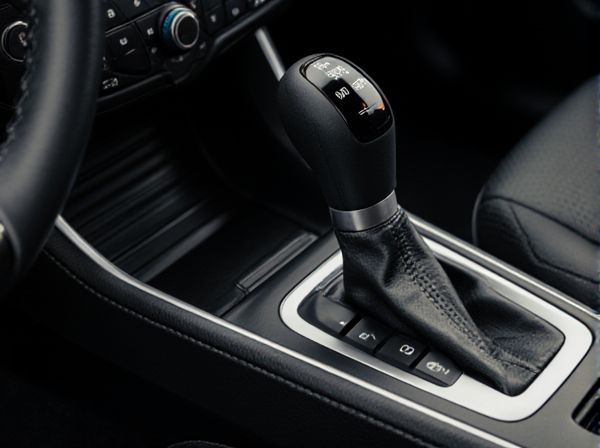
Photo illustration: Paddle-shift Transmission vs Push-button Transmission
Paddle-shift transmission offers a more engaging and precise driving experience by allowing you to manually change gears without taking your hands off the steering wheel. Push-button transmission simplifies gear selection with the touch of a button, enhancing convenience and modern appeal, especially in urban driving conditions. Both systems improve control and efficiency, but paddle shifts prioritize sporty performance while push-buttons focus on ease of use.
Table of Comparison
| Feature | Paddle-shift Transmission | Push-button Transmission |
|---|---|---|
| Control Type | Steering wheel-mounted paddles for manual gear changes | Dashboard or console-mounted buttons for gear selection |
| Driver Engagement | High; allows quick manual shifting with hands on wheel | Moderate; button presses simplify gear changes |
| Shift Response | Instantaneous, sport-oriented gear changes | Generally smooth, slightly delayed response |
| Installation Complexity | Requires integration with steering column electronics | Less complex; mounted on dashboard or console |
| Space Efficiency | Minimal additional space needed | Frees up space by eliminating gear lever |
| Common Use Case | Sports cars, performance vehicles | Luxury sedans, electric vehicles |
| Cost Impact | Moderate increase due to advanced electronics | Variable, often associated with premium models |
Introduction to Modern Transmission Technologies
Paddle-shift transmission offers drivers manual gear control through steering wheel-mounted levers, enhancing driving engagement and precision. Push-button transmission provides a fully electronic gear selection system, improving cabin ergonomics and simplifying gear changes with intuitive controls. Both technologies represent advancements in modern transmission design, optimizing performance and user experience in contemporary vehicles.
What is a Paddle-shift Transmission?
A paddle-shift transmission is a type of semi-automatic gearbox allowing drivers to manually change gears using levers located behind the steering wheel. This system provides quicker gear shifts compared to traditional manual transmissions and enhances driving engagement without the need for a clutch pedal. Common in sports cars and performance vehicles, paddle-shift transmissions combine the convenience of an automatic with the control of manual shifting.
Understanding Push-button Transmission Systems
Push-button transmission systems streamline gear selection by replacing traditional levers or paddles with electronic buttons, enhancing ease of use and reducing physical effort. These systems often integrate with advanced vehicle controls, providing precise gear shifts and improved customization options for driving modes. Unlike paddle-shift transmissions, which rely on manual input via steering-mounted levers, push-button systems emphasize a modern, ergonomic interface that supports seamless automatic and semi-automatic driving experiences.
Key Differences Between Paddle-shift and Push-button Transmissions
Paddle-shift transmissions offer manual gear control through levers behind the steering wheel, enhancing driving engagement and precision. Push-button transmissions use buttons on the dashboard or center console to shift gears, providing ease of use and a streamlined interior design. The key difference lies in the tactile experience and level of driver involvement, with paddle-shifts favoring sportier, performance-oriented driving and push-buttons emphasizing convenience and simplicity.
Performance and Driving Experience Comparison
Paddle-shift transmission enhances performance by enabling rapid gear changes without removing hands from the steering wheel, resulting in improved control and a sportier driving experience. Push-button transmission offers a seamless and intuitive gear selection process, prioritizing convenience over aggressive performance feedback. While paddle shifters excel in precision and driver engagement during spirited driving, push-button systems provide smooth transitions suited for everyday comfort and ease of use.
User Interface and Ease of Operation
Paddle-shift transmissions offer a tactile, race-inspired interface allowing drivers to manually control gear changes with thumb-operated levers located behind the steering wheel, enhancing driver engagement and precision. Push-button transmissions replace traditional gear selectors with dashboard-mounted buttons, streamlining gear selection and simplifying operation by eliminating the need for physical shifting movements. Both interfaces improve ease of use, but paddle shifts cater to enthusiasts seeking direct control, while push-buttons prioritize convenience and minimal distraction.
Reliability and Maintenance Factors
Paddle-shift transmissions offer enhanced reliability due to their mechanical linkage design, which generally requires less electronic intervention, reducing potential failure points and simplifying maintenance. Push-button transmissions rely heavily on electronic systems and sensors that can be more prone to malfunctions, necessitating regular diagnostics and updates to maintain optimal performance. Maintenance for paddle-shift systems typically involves standard clutch and transmission inspections, while push-button setups demand specialized electronic component servicing and software calibrations.
Safety Features and Concerns
Paddle-shift transmissions offer enhanced driver control by allowing manual gear changes without removing hands from the steering wheel, which can improve reaction times and reduce distraction during critical driving moments. Push-button transmissions simplify gear selection with electronic controls but may pose safety concerns if buttons are pressed inadvertently or if the system experiences software malfunctions, potentially leading to unintended gear shifts. Manufacturers mitigate risks in both systems through features like automatic gear lockout, fail-safe modes, and driver alerts to ensure safe and reliable operation under various driving conditions.
Vehicle Applications and Popularity
Paddle-shift transmissions are widely favored in sports cars and performance vehicles for offering rapid, manual gear changes without removing hands from the steering wheel, enhancing driver control and engagement. Push-button transmissions, increasingly popular in luxury and electric vehicles, provide a modern, space-saving design that simplifies gear selection and complements advanced driver-assistance systems. Market trends show paddle-shift systems dominate enthusiasts' markets, while push-button transmissions gain traction in urban and tech-focused vehicle segments.
Conclusion: Choosing the Right Transmission for Your Needs
Paddle-shift transmissions offer precise manual control and faster gear changes, ideal for driving enthusiasts seeking a sporty experience. Push-button transmissions provide convenience and ease of use, appealing to drivers who prioritize simplicity and modern technology. Selecting the right transmission depends on your driving style, preference for engagement versus convenience, and the overall vehicle experience you desire.
 caratoz.com
caratoz.com